全文HTML
--> --> -->在过去几十年中, X射线望远镜[5]在国际上受到广泛关注和研究, 而国内的聚焦望远镜研究主要局限在聚能方面[6-8], 并应用于脉冲星导航[9-11]. 国际方面较著名的X射线望远镜有Chandra[12], XMM-Newton[13], Suzaku[14,15], ASTRO-H[16]和NICER[17]. Chandra望远镜发射于1999年[18], 由四层微晶玻璃研磨后嵌套组成, 望远镜焦距为10.07 m, 角分辨率为0.5′′. XMM-Newton由58层不同倾角的镜片嵌套而成, 镜片制作方法采用电铸镍镀金法[2], 焦距长达7.5 m, 其有效面积高达4500 cm2@1 keV, 角分辨率为13′′. Suzaku[19]属于日本第五代X射线天文卫星, 于2000年成功发射, 反射镜片采用环氧复制法获得, 镜片厚度只有0.22 mm, 其焦距为10.15 m, 有效面积达440 cm2@1.5 keV, 角分辨率为120′′. 日本最新的X射线天文卫星ASTRO-H[20]发射于2016年, 角分辨率为107′′[21], 但由于电子指令故障, ASTRO-H成功发射3 d后与地面失去联系. NICER属于NASA探测中子星计划, 由56个φ100 mm的聚焦镜构成, 每个聚焦镜由抛物面镜片嵌套而成, 属单次反射式聚焦望远镜, NICER总有效面积可达1800 cm2@1 keV[22].
继“慧眼(insight hard X-ray modulation telescope, HXMT)”卫星发射以后, 我国在X射线空间观测领域规划了“爱因斯坦探针(Einstein probe, EP)”和“增强型时变与偏振天文台(enhanced X-ray timing and polarimetry mission, eXTP)”等一系列X射线专项卫星, 其中eXTP作为第一颗由中国主导、多国合作的X射线天文台, 受到广泛关注. 本文针对eXTP卫星载荷X射线聚焦望远镜的光学设计工作, 在光学原理、层间距选择、面型仿真、角分辨率和有效面积计算方面进行了仿真设计, 并最终完成了eXTP聚焦望远镜的光学设计工作.
2.1.X射线聚焦望远镜的光学原理
基于X射线波长短、光子能量大等特点, 一般可采用衍射、折射、反射的方式对X射线进行聚焦, 但衍射和折射式聚焦效率远小于反射式聚焦效率, 且反射式X射线聚焦望远镜具有较高的角分辨率, 更加适合X射线天文观测. X射线聚焦望远镜基于掠入射反射原理研制而成, 标准Wolter-1型望远镜由抛物面和双曲面构成, 且二者为共焦结构, 见图1. 入射光子经抛物面、双曲面两次反射后聚焦于双曲面另外一个焦点处, 标准Wolter-1型聚焦望远镜轴上无像差, 可实现完美成像. 聚焦望远镜镜片参数如(1)式所示, 但一般情况下, 因单层有效面积有限, X射线聚焦望远镜均采用多层嵌套式设计结构以达到工程实用目的. 图 1 X射线聚焦望远镜的光学原理
图 1 X射线聚焦望远镜的光学原理Figure1. Optical principle of X-ray focusing telescope.
多层嵌套式聚焦望远镜的设计采用迭代方法进行, 即外层镜片的出口位置与内层镜片的入口位置直径相同, 根据eXTP卫星接口需求, 本文确定最外层镜片口径为φ476 mm, 镜片长度为600 mm(300 mm抛物面镜 + 300 mm双曲面镜), 焦距为5.25 m, 由(1)式可计算出45层镜片参数, 最内层镜片口径为212.46 mm.
2
2.2.X射线聚焦望远镜的角分辨率分析
角分辨率是衡量X射线聚焦望远镜成像质量的一个重要指标, 其物理意义为在X射线聚焦镜焦斑能量包围函数中, 能量为总焦斑能量50%的包含范围与焦距的比值. X射线聚焦镜的角分辨率可由各部分公差代入的角分辨率平方和确定, 如(2)式所示:
本文从功率谱密度出发仿真了粗糙度对角分辨率的影响,




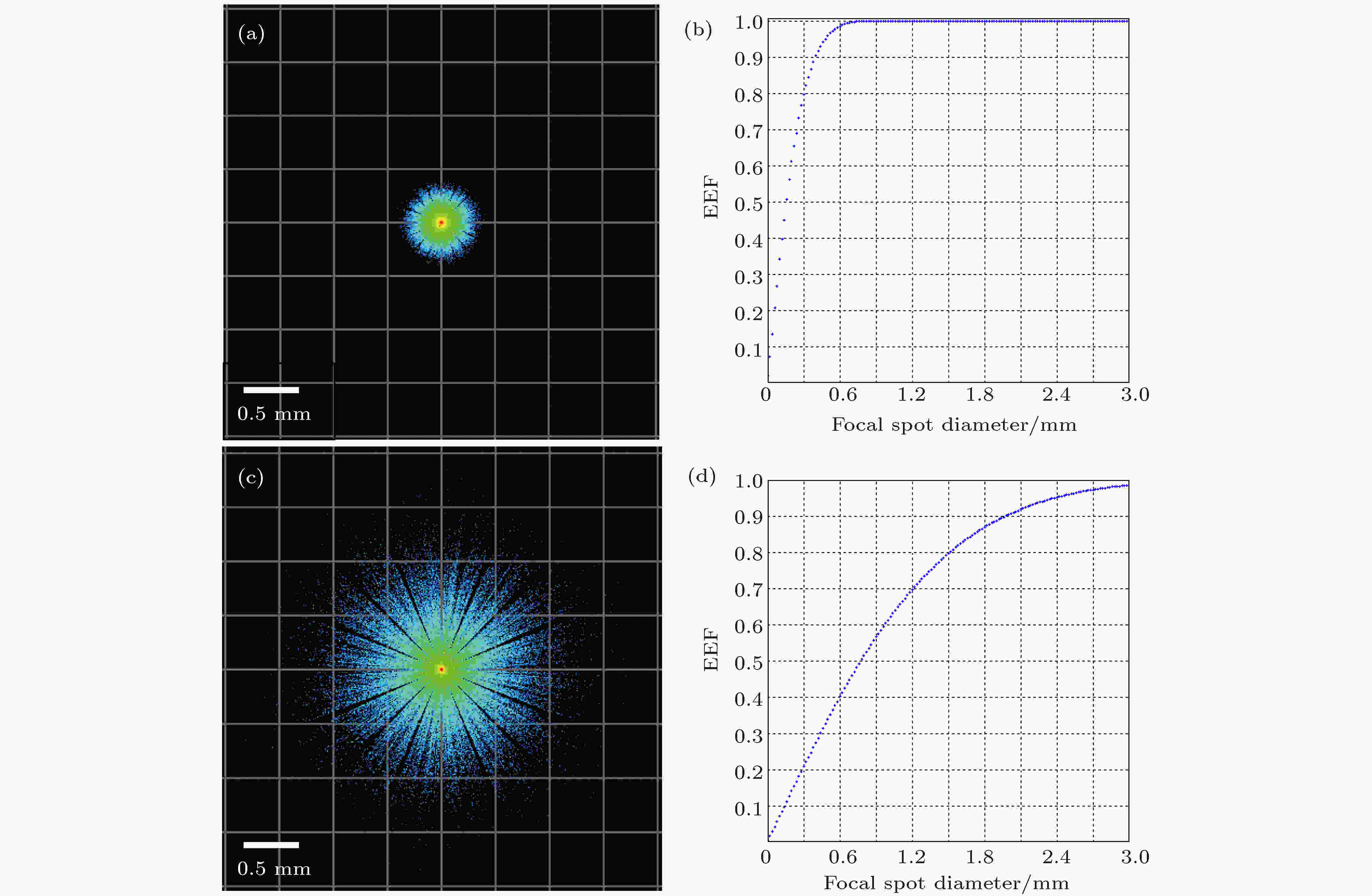 图 2 不同面型精度聚焦镜片的焦斑形状与能量包围函数 (a) RMS 0.04为 μm, PV为0.2 μm, 粗糙度为0.4 nm镜片的焦斑形状尺寸; (b) RMS为0.04 μm, PV为0.2 μm, 粗糙度为0.4 nm镜片的焦斑能量包围函数; (c) RMS为0.2 μm, PV为1 μm, 粗糙度为0.4 nm镜片的焦斑形状尺寸; (d) RMS为0.2 μm, PV为1 μm, 粗糙度为0.4 nm镜片的焦斑能量包围函数
图 2 不同面型精度聚焦镜片的焦斑形状与能量包围函数 (a) RMS 0.04为 μm, PV为0.2 μm, 粗糙度为0.4 nm镜片的焦斑形状尺寸; (b) RMS为0.04 μm, PV为0.2 μm, 粗糙度为0.4 nm镜片的焦斑能量包围函数; (c) RMS为0.2 μm, PV为1 μm, 粗糙度为0.4 nm镜片的焦斑形状尺寸; (d) RMS为0.2 μm, PV为1 μm, 粗糙度为0.4 nm镜片的焦斑能量包围函数Figure2. Focal points and energy encircle functions obtained by mirrors with different profile: (a) Focal point obtained by mirror with profile of RMS 0.04 μm, PV 0.2 μm, roughness 0.4 nm; (b) energy encircle functions obtained by mirror with profile of RMS 0.04 μm, PV 0.2 μm roughness 0.4 nm; (c) focal point obtained by mirror with profile of RMS 0.2 μm, PV 1 μm roughness 0.4 nm; (d) energy encircle functions obtained by mirror with profile of RMS 0.2 μm, PV 0.1 μm roughness 0.4 nm.
图3是X射线聚焦望远镜角分辨率与离焦量的关系, 从图3中可以看出, 对于X射线聚焦望远镜, 焦距处的角分辨率最小, 当像面处于焦点之前或焦点之后时都会影响聚焦望远镜的角分辨率. 当离焦量为5 mm时, 角分辨率由30.6′′降至32′′; 当离焦量为10 mm时, 角分辨率为38′′. 所以, 要提高X射线聚焦望远镜的角分辨率, 增强其成像效果, 不仅要对其面型精度做精度要求, 而且要对焦平面探测器的离焦量做相应要求, 针对聚焦镜角分辨率要求, 最终提出的离焦量为小于4 mm.
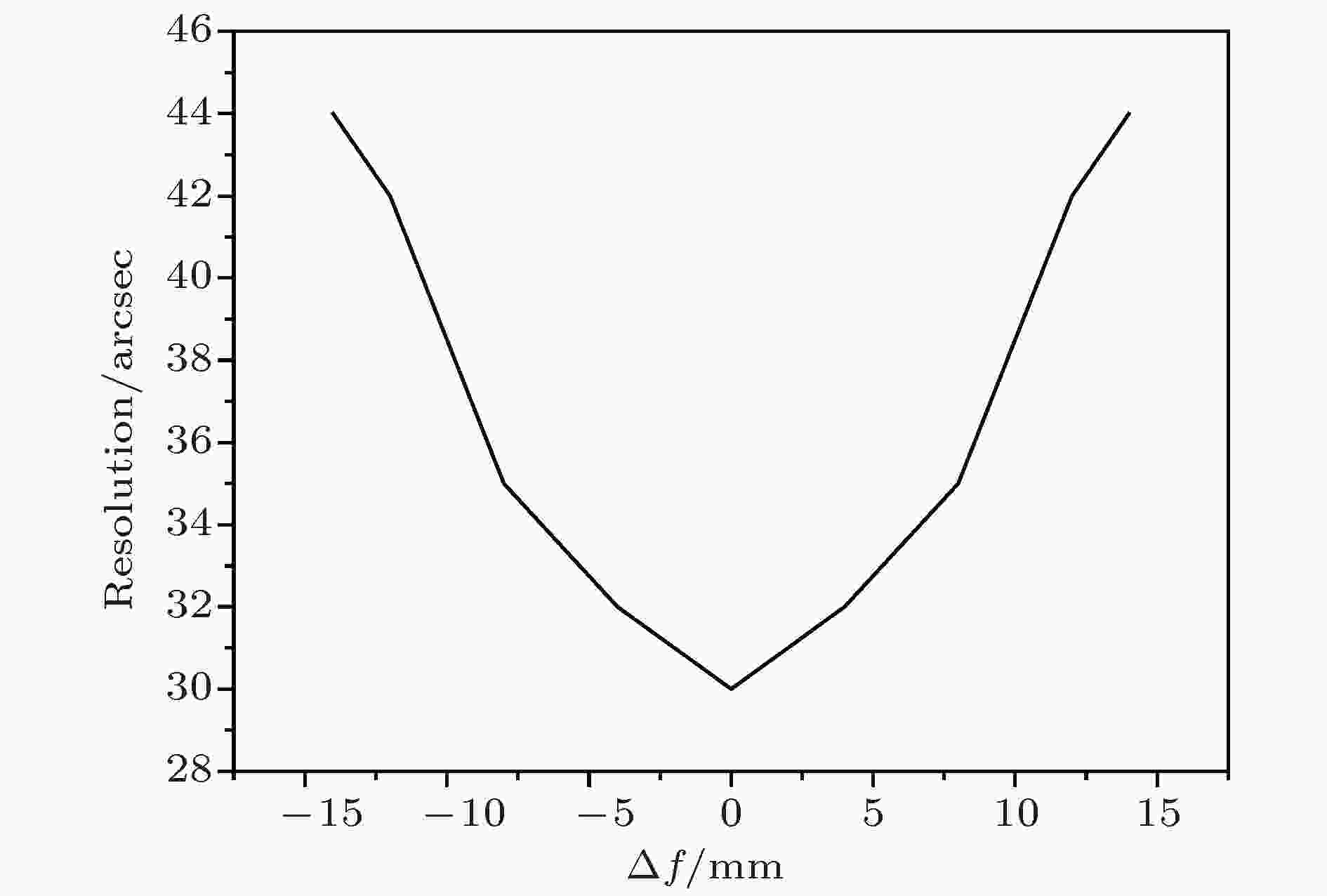 图 3 X射线聚焦望远镜的角分辨率与离焦量的关系
图 3 X射线聚焦望远镜的角分辨率与离焦量的关系Figure3. Relationship between angular resolution and defocus amount in focusing observatory.
2
2.3.X射线聚焦望远镜有效面积
X射线聚焦望远镜的有效面积与其表面膜层材料有直接关系, 因X射线波长短、光子能量大, X射线聚焦望远镜镜片表面必须溅射高原子序数的膜层才能增大其反射效率. 图4为两种不同的膜层结构对X射线的反射效率, 其中图4(a)是膜层材料为Au时, 不同角度下X射线的反射效率, 图4(b)为在Au膜上面制备10 nm的C时其对X射线的反射效率. 从图4中可以看出, 随着掠入射角的增大, X射线反射效率降低, 而且Au和C的复合膜层反射效率明显大于Au膜的反射效率, 并且复合膜层能有效减弱Au膜在2 keV的吸收作用, 提高X射线反射率, 这是因为多层膜结构会对X射线光子产生相干叠加作用, 从而提高了X射线的反射率.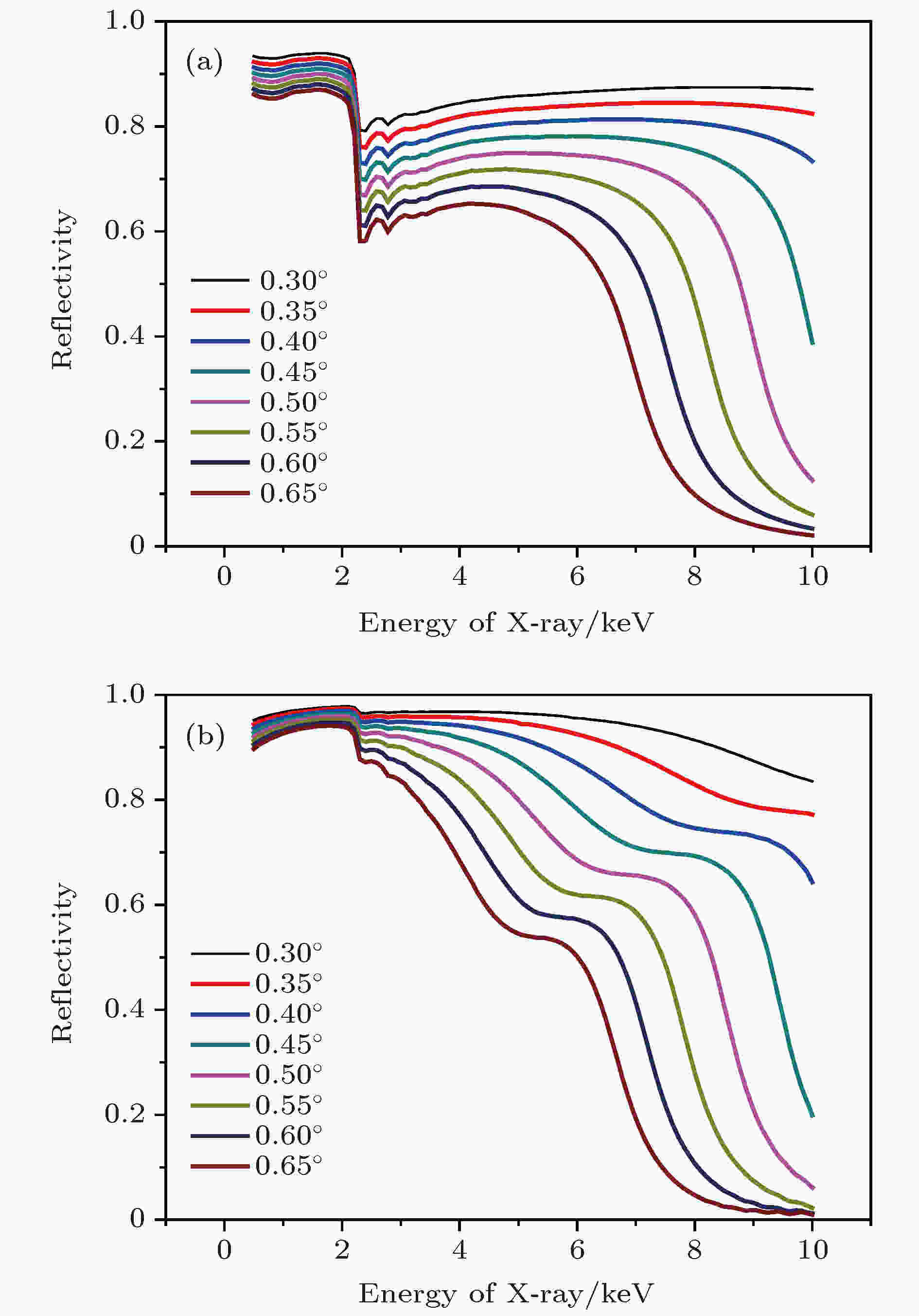 图 4 (a)膜层材料为Au的X射线聚焦望远镜反射率与不同掠入射角的关系; (b)膜层材料为Au加C复合膜的X射线聚焦望远镜反射率与不同掠入射角的关系
图 4 (a)膜层材料为Au的X射线聚焦望远镜反射率与不同掠入射角的关系; (b)膜层材料为Au加C复合膜的X射线聚焦望远镜反射率与不同掠入射角的关系Figure4. (a) Relationship between reflectivity and degree of focusing mirrors with Au film; (b) relationship between reflectivity and degree of focusing mirrors with Au, C multi-layer film.
X射线聚焦望远镜视场的定义是偏轴情况下, 有效面积为在轴有效面积50%时的偏轴角. 图5是X射线聚焦望远镜有效面积与入射光偏轴量的关系, 从图5可以发现, 当X射线聚焦望远镜在偏轴情况下时, 其有效面积随偏轴角增大而减小, 当偏轴角为16′ 时, 其有效面积将降至在轴有效面积的50%, 所以文中设计的聚焦望远镜视场为16′, 而当偏轴角继续增大时, 由于光子已经聚焦在设置的探测器外, 所以其有效面积急速下降.
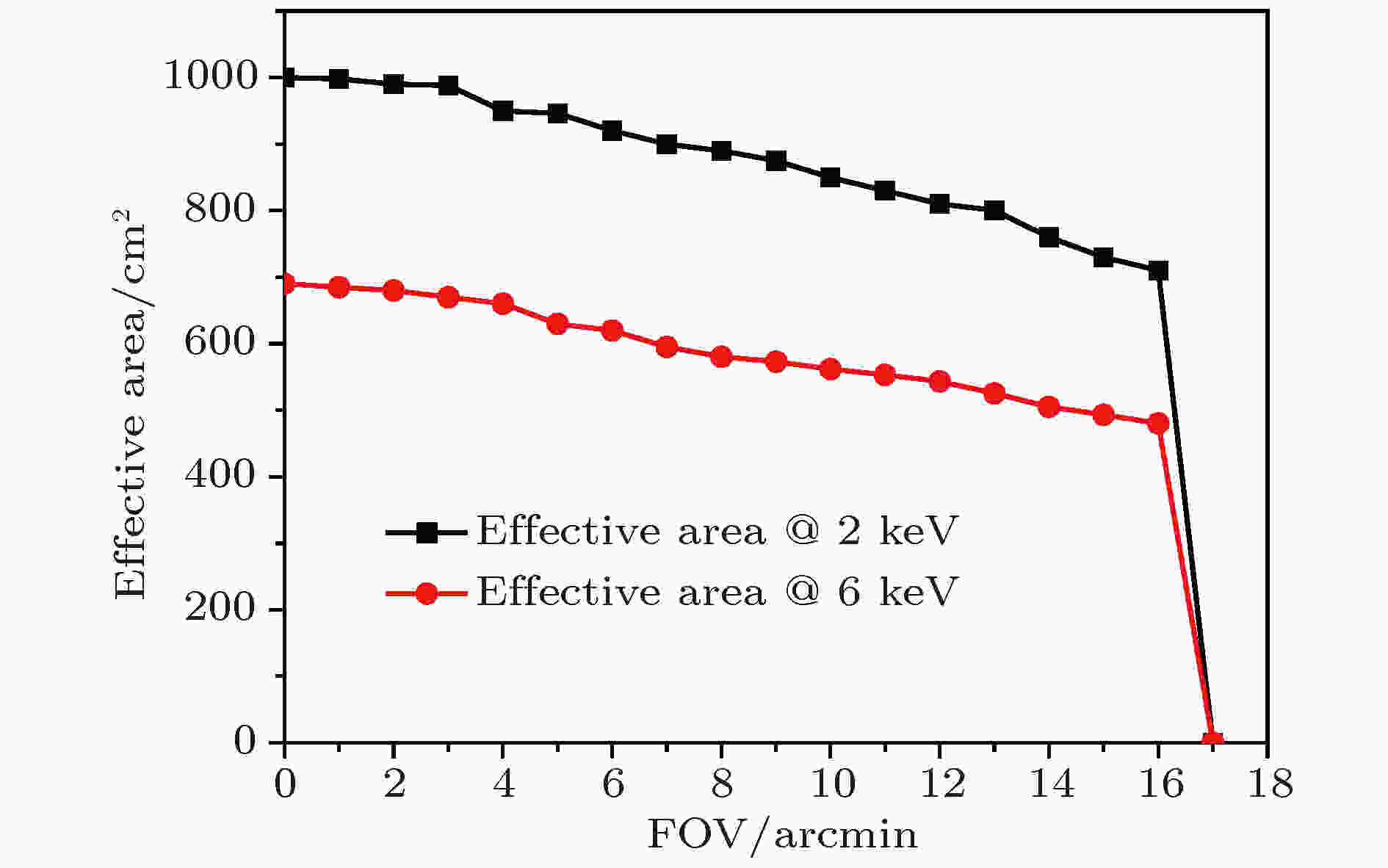 图 5 X射线聚焦望远镜有效面积与偏轴角的关系
图 5 X射线聚焦望远镜有效面积与偏轴角的关系Figure5. Relationship between effective area and off axis in focusing observatory.
图6是X射线聚焦望远镜有效面积随层数、镜片质量的变化关系, 当增大X射线聚焦望远镜有效面积时, 在反射率一定的情况下, 只能通过增多其嵌套层数来解决. 从图6(a)中可以看出, 当嵌套层数增多时, X射线聚焦望远镜有效面积逐渐增大, 但其镜头质量也逐渐增大(图6(b)), 当镜片层数多于45层时, 已完全满足eXTP聚焦望远镜有效面积需求, 并且随着嵌套层数的增加, 内层镜片有效面积贡献能力已非常小, 但卫星总重的增加会提高卫星发射成本, 所以综合考虑有效面积需求与卫星发射成本, 最终确定X射线聚焦望远镜的嵌套层数确定为45层, 其有效面积为842和563 cm2@6 keV.
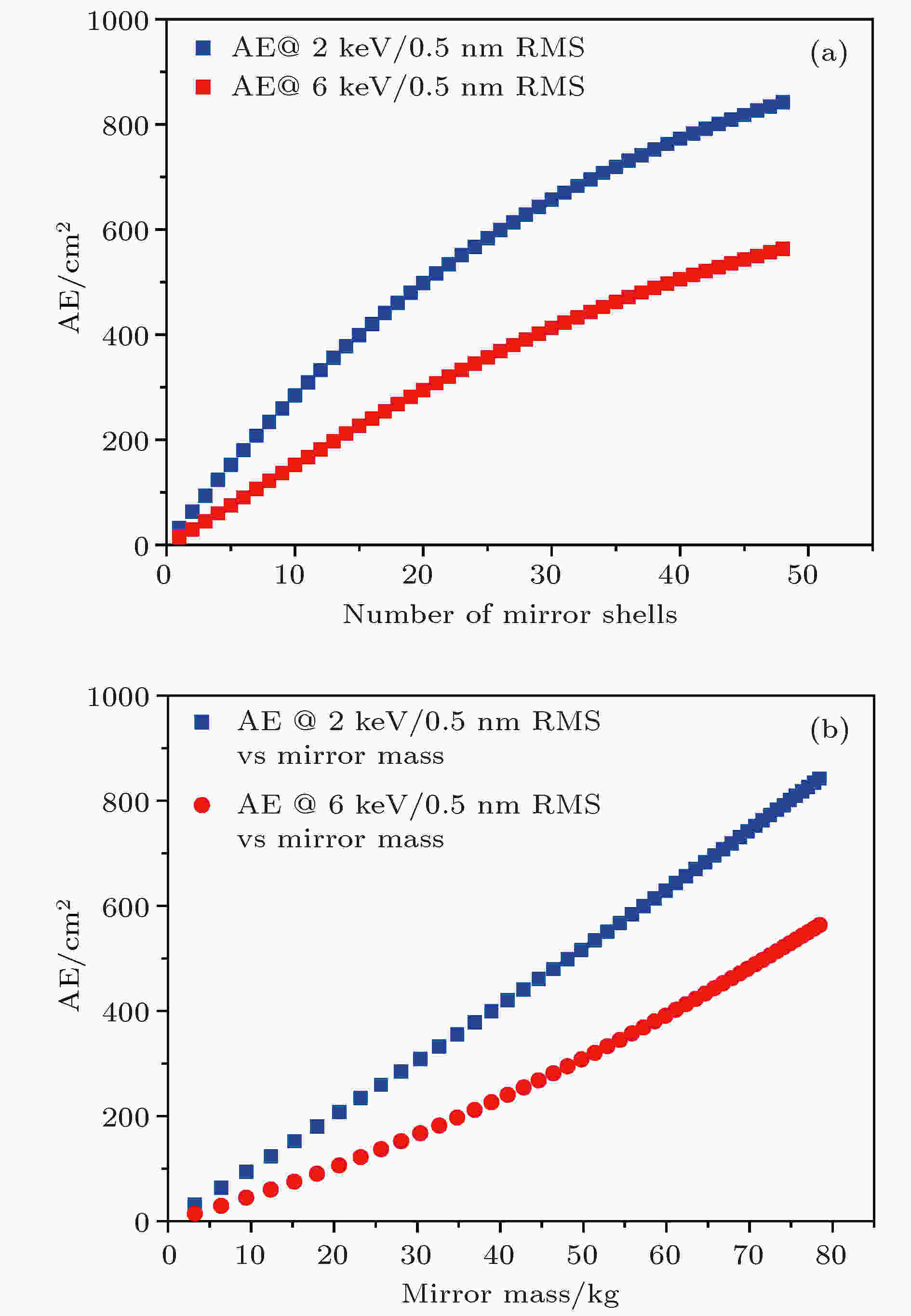 图 6 (a) X射线聚焦望远镜有效面积与嵌套层数的关系; (b) X射线聚焦望远镜有效面积与镜片重量的关系
图 6 (a) X射线聚焦望远镜有效面积与嵌套层数的关系; (b) X射线聚焦望远镜有效面积与镜片重量的关系Figure6. (a) Relationship between and effective area and mirror layers in focusing observatory; (b) relationship between and effective area and mirror weight in focusing observatory
